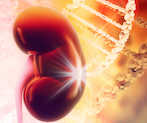Can KDIGO panel guidelines prevent cardiac surgery-associated AKI?

The PrevAKI RCT
EJRC Article Review
Patient morbidity associated with post-operative AKI following cardiac surgery is significant. Despite this we lack any specific therapy for post-cardiac surgery AKI. The management is limited to preventative and supportive measures, for which the evidence is limited. Novel biomarkers including urinary tissue inhibitor of metalloproteinase- 2 (TIMP-2) and insulin-like growth factor binding protein- 7 (IGFBP7) have excellent performance in predicting cardiac surgery associated AKI and can be measured with a bedside point of care device (Nephrocheck) (1).
Meersch et al. conducted a single centre RCT to investigate the benefits of the Kidney Disease Improving Global Outcomes (KDIGO) panel guidelines in preventing cardiac surgery-associated AKI in high risk patients (2). The primary endpoint was the rate of AKI defined by KDIGO criteria within the first 72 h after surgery. Secondary endpoints included AKI severity, need for dialysis, length of stay, and major adverse kidney events (MAKE) at days 30, 60, and 90. MAKE was defined by mortality, need for RRT, and persistent renal dysfunction at day 30, 60, and 90.
Population
Patients with a urinary [TIMP-2]· [IGFBP7] > 0.3 four hours following cardiopulmonary bypass were deemed at high risk of developing AKI and included. 276 patients were enrolled and randomised to either the intervention group (n = 138) or the control group (n = 138).
Intervention
A single-centre trial (University of Muenster (Germany) examined the effect of a “KDIGO bundle” consisting of the following:
• Avoidance of nephrotoxic agents
• Discontinuation of ACEi and ARBs for the first 48 h after surgery
• Close monitoring of serum creatinine and urine output
• Avoidance of hyperglycaemia for the first 72 h after surgery
• Consideration of alternatives to radiocontrast agents
• Close haemodynamic monitoring by using a PICCO catheter with an optimisation of the volume status and haemodynamic parameters according to a pre-specified algorithm
Comparison
The control arm was randomised to standard care, including the following:
• Mean arterial pressure (MAP) >65 mmHg
• Central venous pressure (CVP) between 8 and 10 mmHg.
• Patients received angiotensin converting enzyme inhibitors (ACEi) or angiotensin II receptor blockers (ARBs) once the haemodynamic situation stabilised and hypertension occurred
Outcome
More patients in the intervention group received dobutamine compared to the sham group resulting in a significantly increased MAP and CVP. The rate of hyperglycaemia and use of ACEi and ARBs were significantly reduced in the intervention group compared to the control group. The total administered volume was not different between the two groups.
The overall AKI incidence was 63.4%. The incidence of AKI in the intervention group [76 (55.1%)] compared to the control (99 (71.7%)) group (p = 0.004; OR, 0.483 (0.293–0.796)). In the intervention group significantly lower rates of moderate and severe AKI were observed compared to the control group (41/138 (29.7%) vs 62/138 (44.9%); p = 0.009; OR, 0.518 (0.316–0.851). There were no significant differences for any of the other secondary outcomes, including requirement of RRT during hospital stay, ICU and hospital stay as well as major adverse kidney events (MAKE) at day 30, 60, and 90.
Discussion
This study demonstrated a decrease in the incidence of AKI using KDIGO panel guidelines. A strength of this study is the early implementation of therapeutic measures to prevent progression to AKI guided by ‘renal injury’ biomarkers rather than the use of serum creatinine. Another strength is the use of a pragmatic and effective intervention. Despite the simplicity of the intervention, the benefit may lie in the ‘bundle of care’ approach to tackle the multiple etiologies underlying cardiac surgery- associated AKI.
Whilst the intervention may be considered the basic standard of care in many centres, compliance to adhere to the guidelines is generally low in day-to-day practice (3). The benefit of the intervention may have been associated with better haemodynamic monitoring (as a consequence of more inotrope use), resulting in a more personalised care.
The authors acknowledged a non-significant trend towards higher adverse kidney events (in the intervention group early after surgery. Furthermore, as with many single-centre studies, the observed effect size is likely inflated. For these reasons, the authors have highlighted the need for larger RCTs, and are currently conducting a multicentre, prospective, randomised controlled parallel group trial through the ESICM Trials Group – see the PrevAKI webpage for more information.
In summary, the study by Meersch et al. shows promise for the use of AKI biomarkers (TIMP2 and IGFBP7) coupled with a care bundle in preventing cardiac surgery associated AKI. Such an approach may benefit other high-risk groups of patients.
Article review prepared and submitted by EJRC member Nish Arulkumaran, MD (Centre for Intensive Care Medicine, University College London, London, UK).
References
1. Meersch M, Schmidt C, Van Aken H, et al. Urinary TIMP-2 and IGFBP7 as early biomarkers of acute kidney injury and renal recovery following cardiac surgery. PLoS One 2014; 9:e93460
2. Meersch M, Schmidt C, Hoffmeier A, et al. Prevention of cardiac surgery-associated AKI by implementing the KDIGO guidelines in high risk patients identified by biomarkers: the PrevAKI randomised controlled trial. Intensive Care Med 2017; November 2017, Volume 43, Issue 11, pp 1551–1561
3. Levy MM, Pronovost PJ, Dellinger RP, et al. Sepsis change bundles: converting guidelines into meaningful change in behavior and clinical outcome. Crit Care Med 2004; 32:S595-7